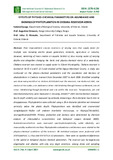| dc.description.abstract | River impoundment creates reservoirs of varying sizes that supply water for multiple uses including electric power generation, domestic, agriculture or industry. However, damming of rivers creates an aquatic habitat of slow moving water of varying depths and altogether changing the biotic and physico-chemical status of a waterbody. Chebara reservoir was created to supply water to Eldoret Municipality. Chebara reservoir is located at 36 05 E and 0 22 S and situated within Elgeyo-Marakwet County. A study was conducted on the physico-chemical parameters and the abundance and biomass of phytoplankton in Chebara reservoir from December 2007 to April 2008. Stratified sampling was done every month at six stations distributed over the reservoir; one station at inlet, one station at the outlet, one stationat a minor inlet draining through human settlement, one at
minor inletdrainingthrough farmland and one within the reservoir. Temperature, pH and
ElectricalConductivity were measured in situusing JENWAY® 3405 Electrochemical Analyser.
Secchi depth visibility was measured by vertically immersing a 25cm diameter Secchi disk to
disappearance. Phytoplankton were collected using a 28 m diameter plankton net immersed
vertically below the photic depth. Phytoplankton was identified and enumerated usingSedgwick—Rafter cell underan invertedor microscope, or Olympus®ModelCK2, atamagnificationofX400. Primary production and biomass were determined by chemical analysis of chlorophyll-a concentration and biological oxygen demand (BOD). Nutrientconcentrations were measured spectrophotometrically, while alkalinity was measuredby acidimetric method. Phytoplankton abundance and biomass were related to the physico-chemical conditions of the reservoir. All statistical analyses were performed with STATIGRAPHIC 2.1 Plus and STATISTICA 6.0 procedures. There were no significant differences in the spatial or temporal physico-chemical parameters. The reservoir was homogenously oligotrophic and alkaline with only very slight variations. among dates and samplingstations. The productivity of Chebara reservoir was low (approximately 0.8 µgmillilitre-1) asestimated by chlorophyll a, suggesting oligotrophy. The highest abundance was observed in March and at station 3,while the lowest abundance in April and at station 5. CCA results indicated strong relationships between the various phytoplankton genera and physical and chemical conditions, except for biological oxygen demand which had a weak effect. The study also indicates that phytoplankton growth in the reservoir is more likely to be limited by
availability of P than N. The results obtained from this study can be useful for tracking the effects of changing activities in the drainage basin and the tributaries that contribute water
directly to the reservoir. Calcium concentrations were consistently low, but the high abundance of pyraphytes in this reservoir could suggest a need to monitor management practices in the reservoir catchment that maintain calcium concentrations and populations of pyraphytes low in order to reduce the water treatment costs. This research further recommends that a research be carried out on macro invertebrates in order to accumulate sufficient knowledge which will be useful for watershed best management practices aimed at ensuring long term protection for water supply.
Keywords: Physico-chemical Parameters; Abundance and Biomass; phytoplankton; Chebara
reservoir | en_US |

